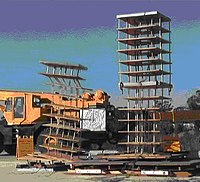
Photo from wikipedia
Abstract On the 12th of June 2017 an earthquake of Mw = 6.3 struck SSE of Lesvos Island, causing one human fatality and severe damage to the built environment. The traditional settlement… Click to show full abstract
Abstract On the 12th of June 2017 an earthquake of Mw = 6.3 struck SSE of Lesvos Island, causing one human fatality and severe damage to the built environment. The traditional settlement of Vrissa was the most affected area, having masonry structures as the majority of its building stock. The objective of the present study is two-fold: to present the structural damage and failure patterns induced by the Lesvos earthquake to masonry structures; to highlight the causes and weaknesses that led to damage, or the factors that prevented it. Particular attention is paid to traditional construction techniques and architectural features that contributed to the seismic response of the structures, either having beneficial or detrimental effect. To this end, a field reconnaissance has been conducted and meaningful technical conclusions are drawn by the observations. Structural systems of both unreinforced and timber-reinforced masonry are inspected. Besides the identification of frequent cases of local, out-of-plane and in-plane mechanisms, combined global mechanisms are also pointed out. Finally, insight into the performance of past interventions is also given, assisting the challenging task of engineering practice.
Journal Title: Engineering Failure Analysis
Year Published: 2020
Link to full text (if available)
Share on Social Media: Sign Up to like & get
recommendations!